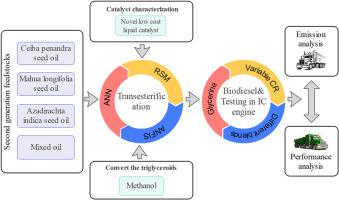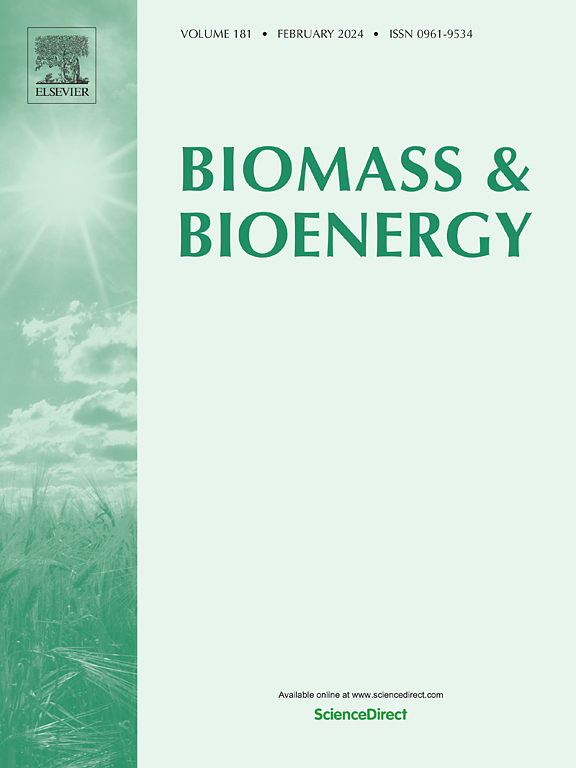利用先进的计算技术和新型双功能液化催化剂从混合非食用油中优化生物柴油生产:集成电路发动机兼容性评估
IF 5.8
2区 生物学
Q1 AGRICULTURAL ENGINEERING
引用次数: 0
摘要
可以利用 Ceiba pentandra、Mahua longifolia 和 Azadirachta indica 三种油的协同组合来生产生物柴油,从而有效缓解依赖单一原料所带来的季节性限制。我们制备了一种新型双功能液体催化剂磺酸酯,并通过各种光谱技术对其进行了表征,以确认其高效转化生物柴油的能力。通过 RSM 对甲醇/油比例、温度和搅拌速度进行优化,并根据 ANN 和 ANFIS 预测进行验证,使用 4% 的双功能催化剂,生物柴油产量达到 98%。生物柴油的特性符合 EN 和 ASTM 标准,确保了兼容性。全负荷条件下的发动机测试检验了各种混合燃料(B0-B100)和压缩比(16-20)。在压缩比为 19 时,B20 生物柴油混合物的制动热效率最高,达到 30.42%,制动油耗最低,仅为 0.219 kg/kWh,表现优于其他混合物。除效率提高外,与纯柴油相比,使用更高的生物柴油混合物还大大减少了废气排放。这项研究的结果倡导采用混合非食用油制成的生物柴油作为传统柴油燃料的绿色可持续替代品。本文章由计算机程序翻译,如有差异,请以英文原文为准。

Optimized biodiesel production from mixed non-edible oils using advanced computational techniques and a novel bifunctional liquified catalyst: Compatibility assessment in IC engines
A synergistic combination of oils from Ceiba pentandra, Mahua longifolia, and Azadirachta indica can be harnessed to produce biodiesel, effectively mitigating the seasonal constraints associated with relying on a single feedstock. A novel bifunctional liquid catalyst sulfonate ester was prepared and characterized by various spectroscopic techniques to confirm its capability in efficient biodiesel conversion. Using a 4 % bifunctional catalyst, a 98 % biodiesel yield was achieved, with optimization of methanol/oil ratio, temperature, and stirring speed through RSM, and validation against ANN and ANFIS predictions. The biodiesel properties met EN and ASTM standards, ensuring compatibility. Engine tests under full load conditions examined various blends (B0-B100) and compression ratios (16–20). At a compression ratio of 19, the B20 biodiesel blend outperformed others by achieving the highest brake thermal efficiency of 30.42 % and the lowest brake-specific fuel consumption, measuring just 0.219 kg/kWh. In addition to these efficiency gains, the use of higher biodiesel blends led to a substantial decrease in exhaust emissions relative to pure diesel. The findings from this research advocate for the adoption of biodiesel from mixed non-edible oils as a green and sustainable replacement for conventional diesel fuel.
求助全文
通过发布文献求助,成功后即可免费获取论文全文。
去求助
来源期刊

Biomass & Bioenergy
工程技术-能源与燃料
CiteScore
11.50
自引率
3.30%
发文量
258
审稿时长
60 days
期刊介绍:
Biomass & Bioenergy is an international journal publishing original research papers and short communications, review articles and case studies on biological resources, chemical and biological processes, and biomass products for new renewable sources of energy and materials.
The scope of the journal extends to the environmental, management and economic aspects of biomass and bioenergy.
Key areas covered by the journal:
• Biomass: sources, energy crop production processes, genetic improvements, composition. Please note that research on these biomass subjects must be linked directly to bioenergy generation.
• Biological Residues: residues/rests from agricultural production, forestry and plantations (palm, sugar etc), processing industries, and municipal sources (MSW). Papers on the use of biomass residues through innovative processes/technological novelty and/or consideration of feedstock/system sustainability (or unsustainability) are welcomed. However waste treatment processes and pollution control or mitigation which are only tangentially related to bioenergy are not in the scope of the journal, as they are more suited to publications in the environmental arena. Papers that describe conventional waste streams (ie well described in existing literature) that do not empirically address ''new'' added value from the process are not suitable for submission to the journal.
• Bioenergy Processes: fermentations, thermochemical conversions, liquid and gaseous fuels, and petrochemical substitutes
• Bioenergy Utilization: direct combustion, gasification, electricity production, chemical processes, and by-product remediation
• Biomass and the Environment: carbon cycle, the net energy efficiency of bioenergy systems, assessment of sustainability, and biodiversity issues.
 求助内容:
求助内容: 应助结果提醒方式:
应助结果提醒方式:


